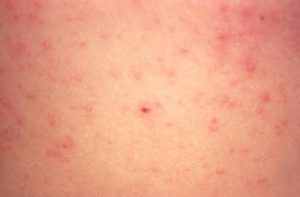Measles update
In an update on the measles situation in California, state health officials are now reporting 23 confirmed measles cases, including 13 outbreak-associated cases as of April 17. Two outbreaks have been linked to patients with international travel

Butte, Calaveras, Shasta, Tehama counties report nine total cases while Santa Clara San Mateo counties are reporting four cases each.
CDC recommends that people get MMR vaccine to protect against measles, mumps, and rubella. Children should get two doses of MMR vaccine, starting with the first dose at 12 to 15 months of age, and the second dose at 4 through 6 years of age. Teens and adults also should also be up to date on their MMR vaccination.
The last large outbreak of measles in California was associated with Disneyland and occurred from December 2014-April 2015, when at least 131 California residents were infected with measles; the outbreak also infected residents of six other states, Mexico, and Canada.
Pertussis death
State health officials have reported the first confirmed infant death from pertussis, or whooping cough this year in a Orange County infant.

Image/David Benbennick
The California Department of Public Health (CDPH) and the Centers for Disease Control and Prevention (CDC) recommend that expectant mothers receive the whooping cough booster shot (also called Tdap, or tetanus, diphtheria and acellular pertussis vaccine) at the earliest opportunity between 27 and 36 weeks of every pregnancy, even if previously immunized. Getting immunized during pregnancy boosts the mother, who then passes some of her protective antibodies on to the fetus. This helps protect newborns until they are old enough to begin receiving their own whooping cough immunizations at 6 to 8 weeks of age.
“To give babies the best protection, I urge all pregnant women to get vaccinated against whooping cough as early as possible during the third trimester of every pregnancy,” said Dr. Karen Smith, CDPH Director and State Public Health Officer. “The best way to prevent whooping cough is by getting vaccinated.”
The symptoms of whooping cough vary by age. For children, whooping cough typically starts with a runny nose and cough for one to two weeks. The cough then worsens and often results in rapid coughing spells that end with a whooping sound. Young infants may not have typical whooping cough symptoms and may have no apparent cough. Parents may describe episodes in which breathing briefly stops and the infant’s face turns red or purple. For adults, whooping cough may be a cough illness that lasts for several weeks.
California reports increase in congenital syphilis for 5th straight year
San Francisco reports big syphilis increases in women
San Francisco reports 1st measles case since 2013
Los Angeles: Increase in whooping cough clusters reported
Flea-borne typhus in Los Angeles County: 107 cases since last year



One thought on “Measles in California update, Pertussis death in Orange County infant”